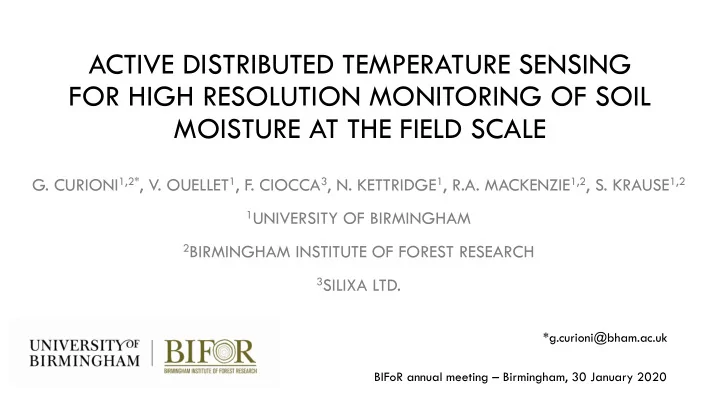

ACTIVE DISTRIBUTED TEMPERATURE SENSING FOR HIGH RESOLUTION MONITORING OF SOIL MOISTURE AT THE FIELD SCALE G. CURIONI 1,2* , V. OUELLET 1 , F. CIOCCA 3 , N. KETTRIDGE 1 , R.A. MACKENZIE 1,2 , S. KRAUSE 1,2 1 UNIVERSITY OF BIRMINGHAM 2 BIRMINGHAM INSTITUTE OF FOREST RESEARCH 3 SILIXA LTD. *g.curioni@bham.ac.uk BIFoR annual meeting – Birmingham, 30 January 2020
BACKGROUND Examples of different soil types Can we understand soil hydrological processes and soil variability at the field scale?
MONITORING SOIL MOISTURE Dielectric sensors COSMOS Remote Sensing (after Blonquist et al. 2005) Large areas but low spatial Volume of soil (< 1 L) resolution A-DTS Lengths up to several km and high spatial resolution
ACTIVE DISTRIBUTED TEMPERATURE SENSING (A-DTS) A-DTS can be used to measure soil moisture at a sub-metre spatial resolution along a fibre- optic (FO) cable Courtesy of AP Sensing In active mode the FO cable is artificially heated and the cumulative temperature increase can be converted to soil moisture Soil moisture (VWC) From Selker et al., 2006
FIELD TEST SITE Field site next to the BIFoR FACE (Free-Air Carbon Dioxide Enrichment) experiment
A-DTS EQUIPMENT Heat Pulse System (Silixa Ltd.) providing constant power during heating (±1 % of the source) • One FO cable at 3 depths down to 0.40 m • Temperature every 30 s • Soil moisture every 6 h (15 min heat pulses, XT DTS (Silixa Ltd.) with sampling resolution of 0.25 m separate for each depth, power rates = 5.8 W/m)
A-DTS CALIBRATION Reference VWC from 5-TE (METER Group) soil moisture sensors Separate calibrations for the different depths (slightly lower RMSE)
PRELIMINARY RESULTS High temporal variability • short-term strongly related to rainfall events • long-term due to prolonged periods (i.e. weeks) of drying and wetting High spatial variability • Lateral across the same slope section and between the two sections • Vertical among the different depths
PRELIMINARY RESULTS Empirical Orthogonal Function (EOF) analysis • Higher small scale spatio-temporal variation at shallow depth • More intense temporal change in the subsoil but more homogeneous spatially (except a few distinct anomalies) • Rainfall is the main driver for change • Prolonged periods of drying and wetting lead to relatively stable conditions
STORM-EVENT ANALYSIS Event1 Oct 2018 Event2 Oct 2018
PRELIMINARY RESULTS • No clear relationship between soil moisture and vegetation (yet!) or topography Soil lens?
SUMMARY A-DTS can be used to measure soil moisture (and temperature) at an unprecedented spatial and temporal resolution at the field scale High spatio-temporal variation of the soil moisture was observed (>10% across the field at any time, and up to 25% within a matter of days or a few weeks) Rainfall (or lack of rainfall) is the main driver for change, and the spatio-temporal variation of soil moisture was little affected by topography and vegetation Infiltration is strongly dependent on previous soil conditions Future goal: Long-term monitoring can help understanding changes in hydrology due to vegetation dynamics (plant-soil-water interactions)
G. Curioni * , V. Ouellet, F. CIocca, N. Kettridge, R.A. MacKenzie, S. Krause *g.curioni@bham.ac.uk Twitter: @giuliocurioni Thanks to
Recommend
More recommend